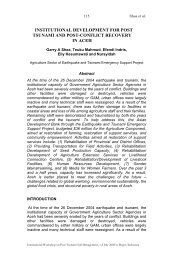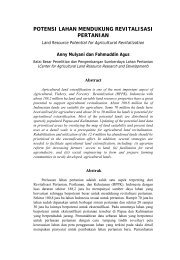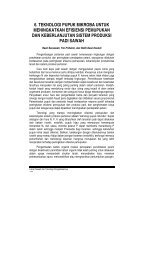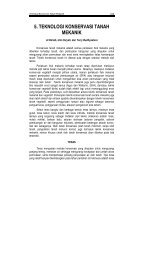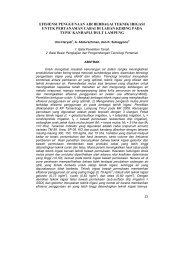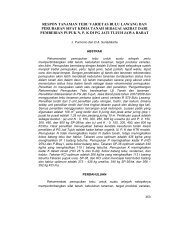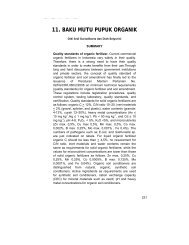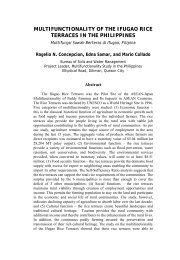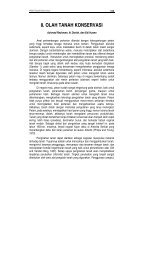Proceedings - Balai Penelitian Tanah
Proceedings - Balai Penelitian Tanah
Proceedings - Balai Penelitian Tanah
You also want an ePaper? Increase the reach of your titles
YUMPU automatically turns print PDFs into web optimized ePapers that Google loves.
144<br />
Wahyunto et al.<br />
Soil, climate and other physical environment data (slope, topography,<br />
surface drainage etc) were used to assess a land suitability levels of<br />
various agricultural crop commodities as described in Guidelines for<br />
Land Evaluation (ISRI, 2003). Therefore, Physiographic unit as a<br />
mapping unit is established in order to present the information of soil<br />
characteristic and its environment distribution that have similar<br />
potential development of agriculture crops. This mapping unit is based<br />
on the similarity of terrain, slope, soil surface texture, drainage,<br />
organic layer thickness and tidal, flood inundation and erosion hazard.<br />
Land suitability evaluation for selected economic tree crops and other<br />
agricultural crops were conducted by using Automated Land<br />
Evaluation System (ALES) software package. The crop requirements<br />
were based on “Guidelines for Land Evaluation” by ISRI (2003) and<br />
related references. Adaptation to the guidelines was made as<br />
necessary based on field and laboratory findings. The process of this<br />
evaluation is the matching of crop requirements against land qualities<br />
or characteristics. The law of minimum constrain is applied to<br />
determine the limiting factors of land suitability classes. Selected land<br />
quality in this evaluation includes air temperature regimes, water<br />
availability, rooting condition, nutrient retention, availability of NPK<br />
nutrients, salinity and toxic elements.<br />
In this present study, three suitability classes are recognized in the<br />
Order S Suitability, and a class for order N Not suitable:<br />
Class S1 Highly Suitable: Land having no significant limitations to<br />
sustained application of the given land utilization type, or only minor<br />
limitations that will not significantly reduce productivity or benefits and<br />
will not raise inputs above acceptable level.<br />
Class S2 Moderately Suitable: Land having limitations which in<br />
aggregate are moderately severe for sustained application of the<br />
given land utilization type; the limitations will reduce productivity or<br />
benefits and increase required inputs to the extent that the overall<br />
advantage to be gained from the use, although still attractive, will be<br />
appreciable inferior to that expected on Class S1 land.<br />
Class S3 Marginally Suitable: Land having limitations which in<br />
aggregate are severe for sustained application of the given land<br />
utilization type and will so reduce productivity or benefits, or increase<br />
required inputs, that this expenditure will only be marginally justified.<br />
N Not Suitable order as the range of land utilization types considered<br />
allowed for recommendation of alternatives uses on land whose<br />
present use was found to be Not Suitable<br />
Based on the actual land suitability assessment, it could be grouped<br />
into 4 classes i.e.,: 1 (highly suitable), 2 (moderately suitable), 3<br />
(marginally suitable) and 4 (unsuitable). The main restricting/ limiting<br />
factors can be added to the suitability class are: nr (nutrient retention/<br />
International Workshop on Post Tsunami Soil Management, 1-2 July 2008 in Bogor, Indonesia



